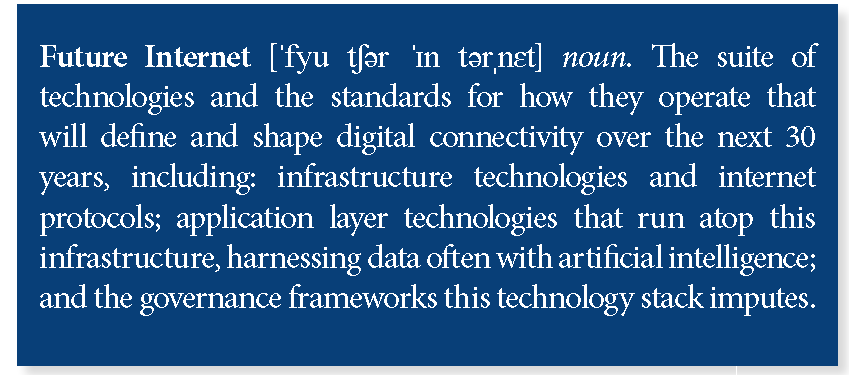Executive Summary
Democracies and Authoritarian Regimes in Competition for the Future Internet
The United States and its democratic allies are engaged in a contest for the soul of the Future Internet. Conceived as a beacon of free expression with the power to tear down communication barriers across free and unfree societies alike, the Internet today faces significant challenges to its status as the world’s ultimate connector.1 In creating connectivity and space for democratic speech, it has also enabled new means of authoritarian control and the suppression of human rights through censorship and surveillance. As tensions between democracies and the People’s Republic of China (PRC) heat up over Internet technologies, the prospect of a dichotomous Internet comes more sharply into focus: a democratic Internet where information flows freely and an authoritarian Internet where it is tightly controlled—separated not by an Iron Curtain, but a Silicon one. The Future Internet is deeply enmeshed in the dawning information contest between autocracies and democracies.2 It is the base layer—the foundation—on which communication takes place and the entry point into narrative and societal influence. How the next generation of Internet technologies are created, defined, governed, and ultimately used will have an outsized impact on this information contest—and the larger geopolitical contest—between democracy and authoritarianism.

China’s growing presence in the global telecommunications market—and the threat that reality poses to the United States and its allies—has catalyzed both national security and economic policy interest in fifth-generation cellular network infrastructure (5G). Like 2G, 3G, and 4G before it, the next generation of mobile connectivity promises a step-change in Internet capability and a societal transformation—through the explosion of connected devices across cities, vehicles, factories, and homes.3 The nascent data-fueled economy 5G Internet will spawn represents a new playing field for nation-state competition in both commercial innovation and systems of governance alike. In this new economy, United States leadership is not assured.
China has made a targeted push to lead the world in the emerging technologies of the future—built on future networks and extending to the applications their data will enable: from artificial intelligence (AI) and autonomous cars to smart grids and advanced manufacturing.4 Chinese telecommunications giant Huawei has by some measures provided the most technical contributions to the 5G standard and last year filed more patents in Europe than any other company.5 Heavy state subsidies provided by the Chinese Communist Party (CCP) have increased the competitiveness of Chinese firms in critical technology industries abroad. As the Pentagon’s Innovation Board bluntly put it: “The country that owns 5G will own many of these innovations and set the standards for the rest of the world … That country is currently not likely to be the United States.”6
A Threat Beyond Espionage
The severity of threat that Chinese leadership poses to the Future Internet has been hotly contested in the United States, across the Atlantic, and around the world. In most cases, the United States has driven this debate through a narrow, albeit important lens: using diplomatic efforts, unsealed indictments, and the sharing of U.S. intelligence, it has attempted to persuade allies that the inclusion of equipment made by Chinese telecommunications giant Huawei into national 5G networks would represent an unacceptable security risk.7 According to the U.S. intelligence community and an increasing number of allied intelligence services, this risk is increasingly objectionable.8 Many U.S. allies in Europe and around the globe will make decisions about Huawei’s participation in their national 5G networks in the coming months. The consequences may last decades.
But the concerns around a growing authoritarian Internet go beyond espionage alone and even beyond Internet and telecommunications infrastructure itself. This report argues that competing in and securing the Future Internet—in 5G, 6G, and the generations and especially the applications to follow—is a crucial U.S. and allied national security interest. It also demonstrates how the current U.S. and allied approach suffers from strategic myopia on both sides of the Atlantic by over-focusing on traditional espionage without due consideration for the ways in which infrastructure dominance will create industry and application dominance—and permeate governance.
As such, the report provides a roadmap for contesting China’s growing dominance in this critical information arena across infrastructure, application, and governance dimensions—one that doubles down on geostrategic interests and allied cooperation. An allied approach that is rooted firmly in shared values and resists an authoritarian divide-and-conquer strategy is vital for the success of democracies in commercial, military, and governance domains.
Across the infrastructure, application, and governance dimensions, the report uses open source reporting, corporation records, case studies, vignettes, and original research to detail China’s use of infrastructural dependence for geopolitical manipulation; its history of intellectual property theft as well as the U.S. and European understanding of this activity and the loopholes in their attempts to counter it; the connection between personal data and the CCP Propaganda Department as “new oil”; China’s increasing role in international standards bodies and how it uses that presence to advance both technology and authoritarian governance norms; and the emerging synergistic relationship between one international technical organization and the Belt and Road Initiative (BRI In some areas, the report draws on transatlantic consultations to hone in on the approach of the United States and its European allies, recognizing that while many democratic nations face similar challenges, a one-size-fits-all approach is rarely an accurate depiction of reality. Finally, it includes 47 concrete recommendations for the United States and democratic governments to strengthen their hand in Future Internet industries. Engaging in authoritarian mimicry will not secure the Future Internet for open economies and open communications. Democracies need to capitalize on their own strengths to respond effectively.
Key Findings
- The report identifies ten key findings on China’s efforts across the infrastructure, application, and governance dimensions of the Future Internet. These findings provide a picture of where democracies should focus—across technology development and standards-setting—to compete and defend their values in the Internet-of-Everything era.
- The CCP has a history of creating infrastructure dependence and using it for geopolitical leverage. As such, China’s global market dominance in Future Internet infrastructure carries unacceptable risks for democracies.
- The contest to shape 6G standards is already underway, with China leading the charge internationally. As the United States ponders how it ended up on the back foot on 5G, China is moving ahead with new proposals that would increase authoritarian control and undermine fundamental freedoms.
- The battle over the Future Internet is playing out in the Global South. As more developed nations eschew Chinese network equipment, democracies’ response has largely ignored this global build-out of networks and applications in the proving ground of the developing world that threaten both technological competitiveness and universal rights.
- China is exporting “technology to anticipate crime”—a dystopian future police state. “Minority report”-style pre-criminal arrests decimate the practice of the rule of law centered in the presumption of innocence.
- Personal Data Exfiltration: CCP entities see “Alternative Data” as “New Oil” for AI-driven applications in the Internet-of-Everything. These applications provide new and expanded avenues for mass data collection, as much as they depend on this data to succeed–giving China the means and the motivation to vacuum up the world’s data.
- Data in, propaganda out: Future Internet technology presents opportunities to influence the information environment, including the development of information applications that simultaneously perform big data collection. Chinese companies are building information platforms into application technologies, reimagining both the public square and private locales as tools for propaganda.
- Already victims of intellectual property theft by China, the United States and its democratic partners are ill-prepared to secure sensitive information as the Future Internet ecosystem explodes access points. This insecurity will continue to undermine technological competitiveness and national security and compound these effects in new ways.
- China outnumbers the United States nearly two-to-one on participation in and leadership of critical international Future Internet standards-setting efforts. Technocratic standards bodies are becoming unlikely loci of great power technical competition, as Beijing uses leadership posts to shape the narrative and set the course for the next generation of Internet technologies to support China’s own technological leadership, governance norms, and market access.
- The world’s oldest UN agency is being leveraged as a propaganda mouthpiece for the CCP’s AI and Future Internet agenda, whitewashing human rights abuses under a banner of “AI for Good.” The upshot is an effort to shape the UN Sustainable Development agenda to put economic development with authoritarian technology–not individual liberty—at their center.
- A symbiotic relationship has developed between China’s Belt and Road Initiative and UN agencies involved in Future Internet and digital development. In this way, China leverages the United Nations enterprise to capture market dominance in next generation technologies.
Recommendations
The report includes 47 concrete strategic and tactical policy recommendations democracies should adopt to succeed in the Internet-of-Everything era while advancing the democratic values of human rights, transparency, and freedom from tyranny. When practicable, these recommendations embrace a multilateral frame that envisions democracies as strategic partners in the defense and promotion of these values, along five key dimensions:
Counter China’s Structural Advantages in Future Internet Development and Deployment
Offsetting China’s cross-societal play requires adequate coordination in government. In the United States, the White House should create a Technology Directorate at the National Security Council and appoint a Future Internet Director with a joint appointment at the White House Office of Science and Technology Policy to coordinate an interagency task force on U.S. and democratic global competitiveness to build out and implement a cross-cutting Future Internet strategy.
The director should also establish a private sector working group of industry representatives; plan for 6G now by leading a public-private coalition on 6G experimentation, standards, and spectrum, in coordination with democratic partners; develop an interagency digital development agenda including a focus on the application and governance dimensions of the Future Internet, and provide national security input to economic and trade policy. European partners should tailor analogous structures to national environments, with an emphasis on bridging communication and decision-making between economics ministries and ministries of foreign affairs on matters of technology and national security.
Construct Allied Solutions for the Developed and Developing Worlds
The United States cannot compete on its own: unilateral tech policy is vulnerable to claims of protectionism, and in many areas U.S. allies are out front. A transnational alliance of democracies such as Britain’s “D10” should fuse expertise and build collective political will to ensure the Future Internet is an open and democratic one. The D10 should create a multilateral “Trusted Internet” or “Trusted Cyber” standard based on the Prague Proposals for 5G and 6G infrastructure systems, hold a summit with the goal of drafting democratic principles for the application layer of the Future Internet, and stablish three joint Future Internet Research and Development (R&D) Centers of Excellence (CoE) on infrastructure, applications, and governance in North America, Europe, and the Asia-Pacific. The standard should include the development of sustainable off-ramp plans and be used as input into new OECD member accession decisions, and the output of the application layer summit should include a rubric for evaluating information apps in democracies.
Increase Allied Coordination and Activity in International Standards Bodies
One reason China is writing the new global rules at international standards bodies is that the United States and its allies are not coming together to defend their shared values or to clarify what they mean in the digital arena. The D10, in coordination with the private sector, should conduct ongoing monitoring and assessment of the proceedings of international standards bodies (such as the Third Generation Partnership Project (3GPP), the UN International Telecommunications Union (ITU), and International Organization for Standardization (ISO)). This effort should provide an allied coordination function in advance of key meetings on standards that implicate democratic governance, as well as ongoing assessment of PRC bloc action to advance specific features that advantage Chinese companies or promote authoritarian Internet governance norms in infrastructure or application standards. The D10 should also build a minimum common understanding of governance norms that should shape a democratic Future Internet and work to install democratic leadership in key positions and focus groups.
Secure the Future Internet
Information security and data privacy must be pillars of a Future Internet for democracies – across both the infrastructure and application layers. Nationally in the United States, Congress should pass comprehensive federal data protection legislation including cybersecurity standards for IoT devices and applications and transparency around data brokers. The U.S. and allied intelligence communities should conduct comprehensive, end-to-end 5G cyber risk assessments across the entire Future Internet technology stack. At the international level, NATO should update its cost-sharing structure to count a portion of excess nation spending on secure 5G and 6G infrastructure towards its two percent defense spending goals; update its telecommunications security requirements to align with the Prague Proposals; and conduct a forward-looking security assessment of future NATO communications infrastructure into 5G and 6G that includes an assessment of quantum information progress.
Contest Unfair Business Practices and Build Resiliency to Intellectual Property Theft
In the cyber domain, the United States suffers from a tragedy-of-the-commons problem in which companies are not incentivized to come forward to report cyber intellectual property (IP) theft, especially from China, due to fear of business repercussions. How and by whom data is stored, handled, accessed, and shared are central to the distinction between democracy and autocracy. Democracies should extend and amplify that distinction. Congress should pass comprehensive federal data protection legislation that includes a breach notification requirement as a matter of corporate governance. The European Union should form a Commission on the Theft of European Intellectual Property to study the costs of economic espionage and IP theft in Europe.
- Lindsay Gorman, “A Silicon Curtain is Descending: Technological Perils of the Next 30 Years,” The German Marshall Fund of the United States, September 13, 2019.
- Laura Rosenberger and Lindsay Gorman, “How Democracies Can Win the Information Contest,” The Washington Quarterly, June 16, 2020; Laura Rosenberger, “Making Cyberspace Safe for Democracy: The New Landscape of Information Competition,” Foreign Affairs, May/June 2020.
- Barry McCall, “5G: a transformative technology,” The Irish Times, December 4, 2019.
- The State Council of the People’s Republic of China, “Made in China 2025,”; The State Council of the People’s Republic of China, Made in China 2025, July 7, 2015.
- Dan Strumpf, “Where China Dominates in 5G Technology,” The Wall Street Journal, February 26, 2019; NB:There is some dispute on how patent power is measured. Tim Pohlmann, Who is leading the 5G patent race? A patent landscape analysis on declared 5G patents and 5G standards contributions, IPlytics, November 2019; Susan Decker, “Huawei Bets Big on European 5G Patents Despite Trump’s Pressure,” Bloomberg, March 12, 2020; Christina Petersson, “Why you shouldn’t believe everything you read about 5G patents,” Ericsson, October 11, 2019.
- Milo Medin, et al., The 5G Ecosystem: Risks and Opportunities for DoD, U.S. Department of Defense, April 3, 2019.
- David E. Sanger, et al., “In 5G Race With China, U.S. Pushes Allies to Fight Huawei,” The New York Times, January 26, 2019; U.S. Department of Justice, “Chinese Telecommunications Conglomerate Huawei and Subsidiaries Charged in Racketeering Conspiracy and Conspiracy to Steal Trade Secrets,” February 13, 2020; U.S. Department of Justice, “Chinese Telecommunications Device Manufacturer and its U.S. Affiliate Indicted for Theft of Trade Secrets, Wire Fraud, and Obstruction Of Justice,” January 28, 2019; Bojan Pancevski, “U.S. Officials Say Huawei Can Covertly Access Telecom Networks,” The Wall Street Journal, February 12, 2020.
- Mike Rogers et al., Investigative Report on the U.S. National Security Issues Posed by Chinese Telecommunications Companies Huawei and ZTE (“House Huawei Report”), U.S. House of Representatives, October 8, 2012.





